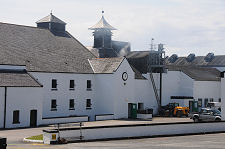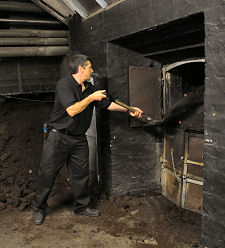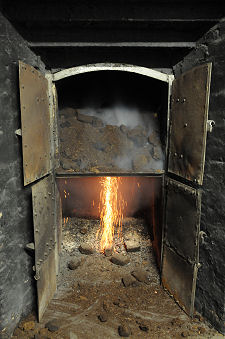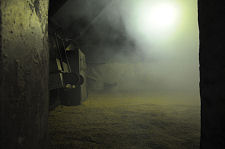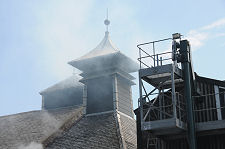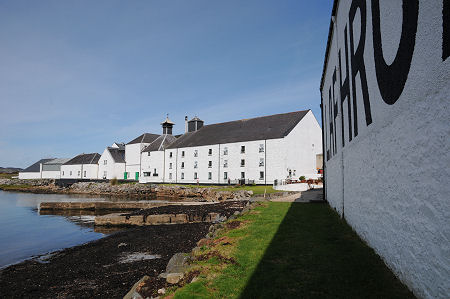 Laphroaig Distillery |
The road east from Port Ellen leads to three world famous distilleries. The first you encounter is Laphroaig, just over a mile from Port Ellen. A turning on your right leads into a stand of trees, and you park in the obvious visitor car park just short of the main distillery gateway. From here a pedestrian route leads down an attractive passage between distillery buildings and past the distillery office to the visitor centre, whose entrance is in the gable end of the more westerly of the two large ranges of buildings which make up so much of Laphroaig.
The two ranges don't quite meet, and the gap between them gives access to the fascinating shoreline of Loch Laphroaig, around which the distillery is built. Visitors can wander freely along the shoreline, and most will do so, if only in order to take photographs of the main distillery buildings on one side, and the bonded warehouse carrying the name "LAPHROAIG" in large black letters on the other. Most of Islay's coastal distilleries have done this and the effect when seen from the Islay ferry sailing into or out of Port Ellen is especially striking when all three of what are known as the Kildalton distilleries are in view.
A number of Islay's distilleries present challenges of pronunciation, and Laphroaig is especially tricky because to the uninitiated there is an obvious, but wrong, way to pronounce the name. The correct pronunciation is "La-froyg". The name probably comes from the Gaelic for "hollow by the big bay", which seems a fair description of the location.
The Visitor Centre at Laphroaig is superb. You enter past racks of Wellington boots, which we will return to presently. Beyond this is the very stylish shop and reception area. And beyond that is a large and nicely presented exhibition area in which you can explore the history of the distillery. The third part of the Visitor Centre is a lounge reserved for "Friends of Laphroaig".
"Friends of Laphroaig" is a world wide club for fans of Laphroaig's distinctively peaty and iodine flavoured whisky. It was launched in 1994 in what can only be described as an act of marketing genius. Applications were attached to every bottle, and anyone old enough to legally consume the whisky could become a friend. The total number of Friends of Laphroaig has now exceeded half a million, and these days it is possible to join online from anywhere in the world, so long as you have to hand the barcode from a bottle of Laphroaig as a proof of purchase. Friends are given a lifetime lease on a square foot of Islay, and if as a friend you visit the distillery you can collect your rent on your own square foot, in the form of a miniature of Laphroaig.
Names and addresses of the first couple of hundred thousand friends were also recorded in large leather registers held in the Friends' lounge at the distillery. On arrival Friends are given their miniature as rent, plus signed certificates which tell them where in the registers they can find their entries, and information on where to find their plot of land, plus a small flag of the nationality of their choice (and there is a wide choice). The plots of land are in a large field on the inland side of the coast road near the distillery, and Friends are invited to go and plant their national flag in their own personal square foot of land. This field looks as if it can get boggy, which is where the racks of Wellington boots come in.
By the time you reach the Visitor Centre, you will probably have noticed one of Laphroaig's most distinctive features, in the form of smoke emerging from the pagoda above the kiln, and the pervasive smell of burning peat. There was a time when every distillery malted its own barley, but in the 1960s and 1970s most turned instead to buying in malted barley from large scale maltings. Today only six distilleries in Scotland have their own maltings. Three of these are on Islay, and Laphroaig is one of them.
This adds a whole new dimension to the usual distillery tour and it is fascinating to see the barley laid out on the malting floors, slowly germinating. When it has reached just the right stage, the malted barley is placed in the kiln, which has the effect of stopping the germination process and of drying the malted barley out to allow milling to take place. Depending on the style of whisky being made, it also allows peat smoke and flavour to penetrate the malt. Laphroaig is a very peaty whisky, and peat is therefore heavily used in firing the kiln. Over the years Laphroaig's productive capacity has outstripped the capacity of its floor maltings, and (in common with other distilleries which maintain their own maltings) a proportion of the malted barley is brought in: in Laphroaig's case this is about two thirds.
You can find out more about Making Malt Whisky from our series of feature pages showing the stages in the process. The next major stage on view at Laphroaig is the milling of the malted barley, and things then move on to the very large stainless steel mash tun. The six washbacks and ancilliaries such as the yeast tank are also made from stainless steel.
The glass fronted stillhouse at Laphroaig stands across a courtyard from the earlier stages in the process and is home to a proud line of seven stills: three wash stills and four spirit stills. Although the building is relatively modern, the stillhouse has as much character as any you are likely to find anywhere, and the views along the stills and behind them, between the stills and the condensers, are highly impressive. The two large spirit safes are positioned in line with the condensers and behind the stills themselves. Your tour will conclude with a glimpse of one of the bonded warehouses.
Laphroaig Distillery was officially founded by brothers Alexander and Donald Johnston in 1815, though they had farmed in the area for some years before that and it is likely that they had also distilled on this site since about 1810, before deciding to move to the right side of the law. Donald Johnston became sole owner in 1836. Donald drowned after falling into a vat of whisky in 1847, but the distillery stayed in the Johnston family. In 1921 Ian Hunter, related by marriage to the Johnstons, inherited Laphroaig and oversaw its modernisation and expansion. He also pioneered the use of casks previously used for storing bourbon in the USA. Under his guidance Laphroaig became what would now be called a global brand.
Ian Hunter was the last of the family line, and died in 1954. He left the distillery to Bessie Williamson, who had worked alongside him at Laphroaig since 1935. Bessie sold the distillery to Long John International in the 1960s, but continue to work as distillery manager until her retirement in 1972. In 1990 Long John and Laphroaig were taken over by Allied Domecq. In June 1994 Prince Charles visited Laphroaig, presented it with a Royal Warrant, and declared it to be "the finest whisky in the world". In the same year "Friends of Laphroaig" was founded, so perhaps Prince Charles can be regarded as the first of them.
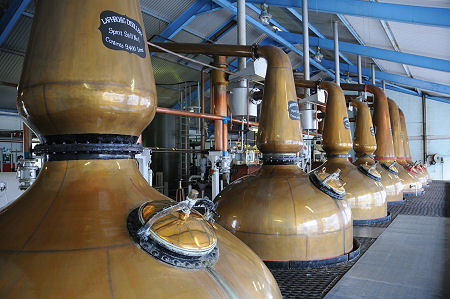 The Stillhouse |

|
|
|
Visitor InformationView Location on MapPort Ellen, Isle of Islay, PA42 7DU. Tel: 01496 302418. Grid Ref: NR 387 452 www.laphroaig.com Opening Hours Tours & Admission What3Words Location: ///cooks.stockpile.farms |
 The Writing on the
Wall The Writing on the
Wall |
 Visitor Centre & Shop Visitor Centre & Shop |
 Exhibition Area Exhibition Area |
 Field Owned by Friends of
Laphroaig Field Owned by Friends of
Laphroaig |
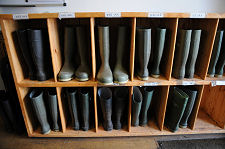 Wellingtons for Friends Wellingtons for Friends |
 Register of Friends Register of Friends |
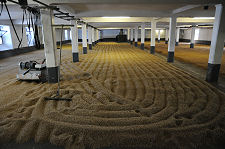 Floor Maltings Floor Maltings |
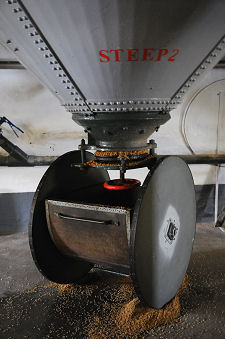 Steep and Chariot |
